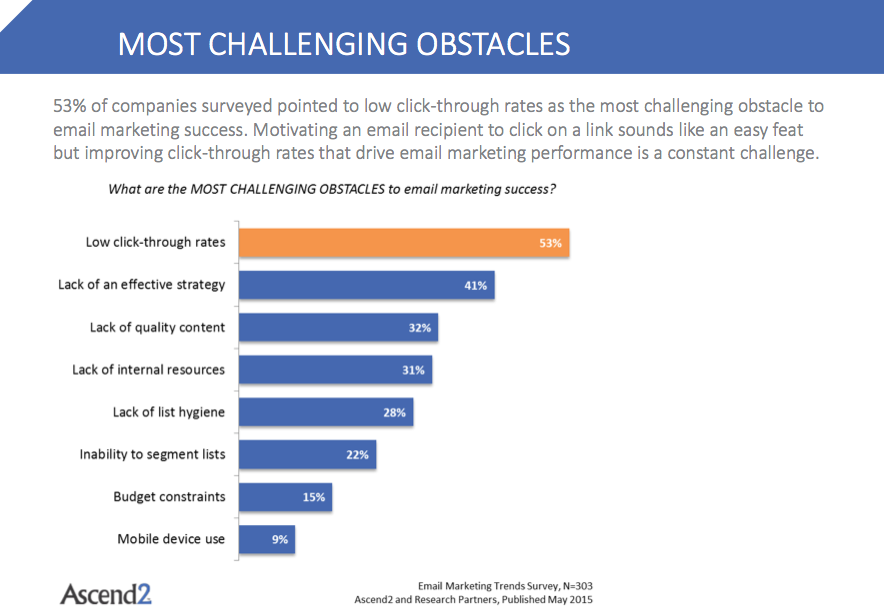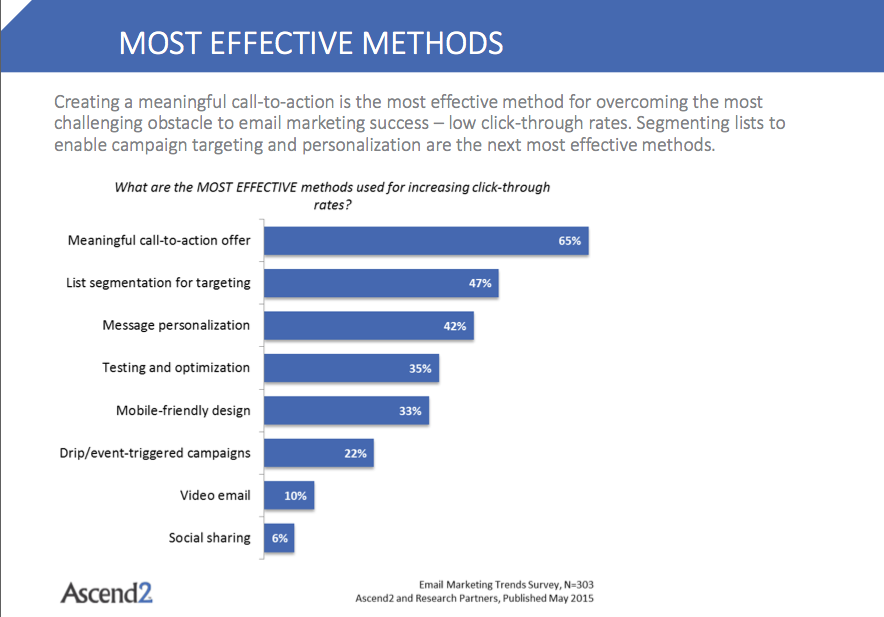New research from Ascend2 shows increasing click through rates is a constant challenge for marketers. Yet it also shows that marketers might be misguided in their attempts to improve CTRs.
In responding to the survey questions for this report, 63% of marketers responded that increasing engagement is one of the most important objectives of an email marketing strategy.
When asked the most useful metric for measuring email marketing success, the click-through rate (CTR) scored highest at 73%. This makes sense. Marketers find CTRs useful metrics because a click through shows engagement even if it doesn’t lead to a conversion. An email has to be opened to have a click through.
However, when asked for the most challenging obstacles to email marketing success, 53% of the respondents cited the CTR.

Are we missing the CTR boat?
When asked the most effective way to increase click-through rates, 65% of respondents said a meaningful call to action.
Maybe we’re putting our focus on the wrong thing. The CTR is a useful metric for measuring engagement, but is a meaningful call to action (CTA) really the answer to CTR troubles? Consider some of the other methods cited as “most effective” by the marketers who responded to this survey:
- List segmentation
- Testing and optimization
- Mobile friendly design

I suspect that these other methods might be just as effective at improving CTRs—if not more than because you need all of these. Consider the call to action compared to each of these:
- List segmentation—If you’re not segmenting, how do you use a call to action that is relevant to a certain segment of your audience and not another?
- Testing and optimization—If you’re not testing, how do you know what works? Maybe the real problem lies in the subject line, or frequency of sends, or something else?
- Mobile friendly design—If you’re relying on your call to action to drive results and your emails aren’t designed for mobile, you’re probably losing out on click throughs with buttons that are too small or linked text that’s too crowded. If someone physically can’t click through, they won’t.
Other reasons why CTAs won’t work
The research indicates other sticking points too, that might also make CTRs harder to improve. Remember above where we said low click-through rates were the biggest challenge to email marketing success? Consider the challenges that were ranked next on the list:
- Lack of an effective strategy 41%
- Lack of quality content 32%
- Lack of internal resources 31%
One could certainly argue that these “lacks” might contribute to the top challenge of low click-through rates. Without an effective strategy in place, great content, and the internal resources to develop the strategy and content—plus test—of course click-through rates will be low.
Are we asking too much of the CTA?
Looking through all of the numbers, I am left thinking that the call to action is being asked to carry too big of a burden. If the other pieces aren’t in place and effective, the call to action can hardly be expected to make up the difference and generate click-throughs, no matter what color you make the button.
The take-away from all of this is the importance of a holistic approach to email marketing. When we single out one piece of the pie as the one to focus on in order to improve results, we lose sight of how all of the pieces fit together to make a whole.



